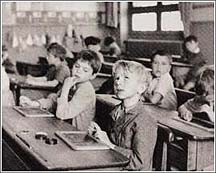Qualifications: Link to Employment
For twenty years, youngsters leaving school without adequate qualifications have been the hardest hit by the increase in unemployment. In the mid 1990s, the best-qualified young people, relatively spared until then, began to find things significantly more difficult. Since 1998, they have, however, been the first to benefit from the general improvement in the first-job market.
A person's future position in society is in fact — to a fairly large extent — dependent on his/her academic achievements. Five years after the end of their studies, people with degrees are five times more likely to hold an executive or middle-ranking managerial position than those who started work immediately after the baccalauréat. The bulk of the people in top jobs in both the engineering field and the professions hold diplomas from a grande école (prestigious higher education institution with a competitive examination) or have successfully completed a third university cycle (7).
While this is reassuring in that it demonstrates the value accorded to academic qualifications, it is also a matter for concern, since the inequalities often picked up very early on in school — and overcome with difficulty — have a lasting effect on an individual's future working life. The aim of continuing education, vital for what is now known as "life-long learning", was originally to offer a second chance, attenuating or correcting the legacy of an inadequate basic education, but it only very imperfectly fulfills this role. At the same time, the idea is gaining ground that experience in a trade is as valid as qualifications obtained at school or in higher education. But the procedures for validating vocational achievements — brought about by the 1985 and 1993 Acts — still face serious obstacles. In 1998, only 12,000 people managed to validate the achievements of their experience, principally in university education. Today, a Bill on Social Modernization envisions an augmentation of the present system so as to offer a genuine second chance to those whose limited skillsets were not detected at school.
Footnotes:
(1) In the French system, forms are numbered from 12 (first year of primary school) to 1, followed by terminale, with the collège beginning in form 6, approximately 11 years of age.
(2) Teachers who are aggregés hold the highest level of professional teaching qualifications, achieved through success in a competitive aggrégation examination.
(3) The New School Year Allowance is means-tested and paid once a year to compensate for the expenses incurred at the start of a new school year.
(4) A technological baccalauréat involves science and tertiary or industrial or laboratory technologies, or medical and social sciences.
(5) A general series baccalauréat involves literature (arts-based), or economics and social sciences, or science.
(6) Military service has now been suspended in France and replaced by the JAPD. All young people, both male and female, have to register and attend this day when France's defense is explained to them.
(7) In France, higher education studies are organized in cycles, as at primary and secondary levels. The first theoretically lasts two years and leads to a DEUG, which is comparable to a Diploma in Higher Education in the UK (Associate's Degree in the U.S.). The second (also two years) leads first — after one year — to the equivalent of a bachelor's degree and then — after a further year — to the equivalent of a higher or master's degree. The third, open only to selected postgraduate students, leads to even higher qualifications and can pave the way to obtaining a PhD.


 In Malaysia institutions of learning are committed to international students' welfare . There is a wide range of off-campus and on-campus accommodation to meet different students' budgets, and all living accommodation is modem and comfortable. Estimated living expenses range from USD 3,000 p.a. to USD 5,000 p.a. and vary from one state to another throughout Malaysia. The cost of living also varies depending on the students' style of living. We have the experience, the people and the facilities - don't give yourself anything less. We welcome you to visit us!
In Malaysia institutions of learning are committed to international students' welfare . There is a wide range of off-campus and on-campus accommodation to meet different students' budgets, and all living accommodation is modem and comfortable. Estimated living expenses range from USD 3,000 p.a. to USD 5,000 p.a. and vary from one state to another throughout Malaysia. The cost of living also varies depending on the students' style of living. We have the experience, the people and the facilities - don't give yourself anything less. We welcome you to visit us!